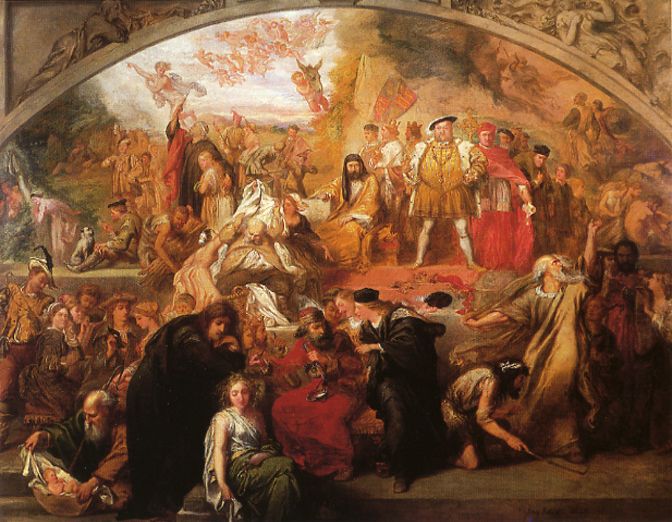My last post was about processions of people dressed as Shakespeare’s characters, especially in relation to David Garrick’s The Jubilee. It’s as if they have a life independent of the plays, so nobody would be surprised to see Falstaff, Juliet or Shylock walking down the street. But artist have also imagined those characters and have also placed them outside the play in which they appear.
The 1709 edition of Shakespeare’s works, for the first time included illustrations of Shakespeare’s characters, as opposed to portraits of actors in costume. The first major exercise in creating paintings of Shakespeare’s characters was the Boydell Shakespeare Gallery that operated from 1789 to 1805. This major project allowed artists to interpret scenes from Shakespeare’s plays as well as imagining some of the scenes he described. The choice of characters and moments from the plays are often the most popular on stage: the ghost appearing to Hamlet, Falstaff being bundled into the buck basket. But sometimes the artists responded to Shakespeare’s descriptions of events such as the murder of the princes in Richard III and the horseback entrance into London of Richard II and Bolingbroke.
But I’ve come across other representations of Shakespeare’s characters from the late eighteenth and nineteenth centuries that strongly remind me of David Garrick’s onstage procession in The Jubilee. The earliest was by Thomas Stothard, whose painting Shakespearean Characters, shown above, was exhibited in 1813. It’s in the form of a frieze, as is his most famous painting, The Pilgrimage to Canterbury, based on Chaucer’s Canterbury Tales. Stothard, born in 1755, would easily have been old enough to see Garrick’s spectacular piece The Jubilee when it was staged between 1769-1776, and he had already shown his interest in Shakespeare by contributing paintings to the Boydell Gallery.
This must have been extremely popular as several different versions still exist. The largest is the one at the Tate Gallery, over 2.5 metres long and nearly 1 metre high. The Victoria and Albert Museum has another, 1.4 metres long, and there’s also a watercolour version at the Whitworth Art Gallery, Manchester (no.D.38.1892).
The second painting I came across was Procession of Characters from Shakespeare’s Plays, dating from around 1840. This was formerly attributed to painter Daniel Maclise, who painted one of the most famous pictures of the play Scene from Hamlet. The actual painter is unknown, and the painting is at the Yale Center for British Art.
Another similar painting that I spotted some time ago (illustrated below), was Sir John Gilbert’s The Plays of William Shakespeare, from 1849. Gilbert too did extensive work on Shakespeare, with his dramatic woodcuts decorating an 1858-1860 edition of Shakespeare’s plays.
The choice of characters indicates the relative popularity of the plays. Stothard, as in the Garrick procession, divides his characters into comedy and tragedy. From the left are characters from Twelfth Night including Olivia and Malvolio, then Falstaff and others from The Merry Wives of Windsor, and Rosalind and Celia from As You Like It, while on the right are Lear and Cordelia, Ophelia and Hamlet, and the Macbeths with the weird sisters. In the centre are Prospero and Miranda from The Tempest, no doubt because Prospero was thought to represent Shakespeare himself. The scenes are very atmospheric, with much use of light and dark.
By contrast the 1840 frieze is rather bland, with no sense of drama, none of the genteel characters doing anything that might upset or offend. On the left is a figure looking like the young Queen Victoria in her coronation robes, followed by characters from a large number of plays: Lady Macbeth, Launce and Crab from The Two Gentlemen of Verona, Bottom from A Midsummer Night’s Dream, figures from Romeo and Juliet, Hamlet, The Taming of the Shrew, The Merry Wives of Windsor, Othello and Twelfth Night.
Gilbert’s painting is full of dramatic action and a galaxy of characters. In the foreground there’s a sort of cradle to grave progression with the finding of baby Perdita in The Winter’s Tale, Hamlet and Ophelia, Shylock and Portia, and Lear in the storm with Poor Tom. Further back are Henry VIII and Wolsey, Falstaff and the merry wives (with the washing), Prospero, Miranda and Caliban. Launce and Crab appear again, and characters from A Midsummer Night’s Dream are rather strangely tucked away. Some of the characters are in famous poses, such as Henry VIII, straight out of a Holbein painting.
There must be many more images of Shakespeare’s characters, but the one I keep thinking of is George Carter’s The Apotheosis of Garrick. Painted in 1782, after Garrick’s death, it shows him being raised to Mount Olympus to be greeted by Shakespeare and the Muses of Comedy and Tragedy. Bidding him farewell are the actors, in character, known for appearing with him in Shakespeare’s plays, varying from the most popular like Hamlet and As You Like It to the less known Measure for Measure and Cymbeline. I know the painting well because it once hung in the RSC’s Picture Gallery. It’s now in store, but here’s the link to the BBC’s Your Paintings website where it can be seen. Looking at the painting now I wonder if it too refers to The Jubilee, when some of the actors portrayed must have appeared in that spectacular procession of Shakespeare’s characters.





